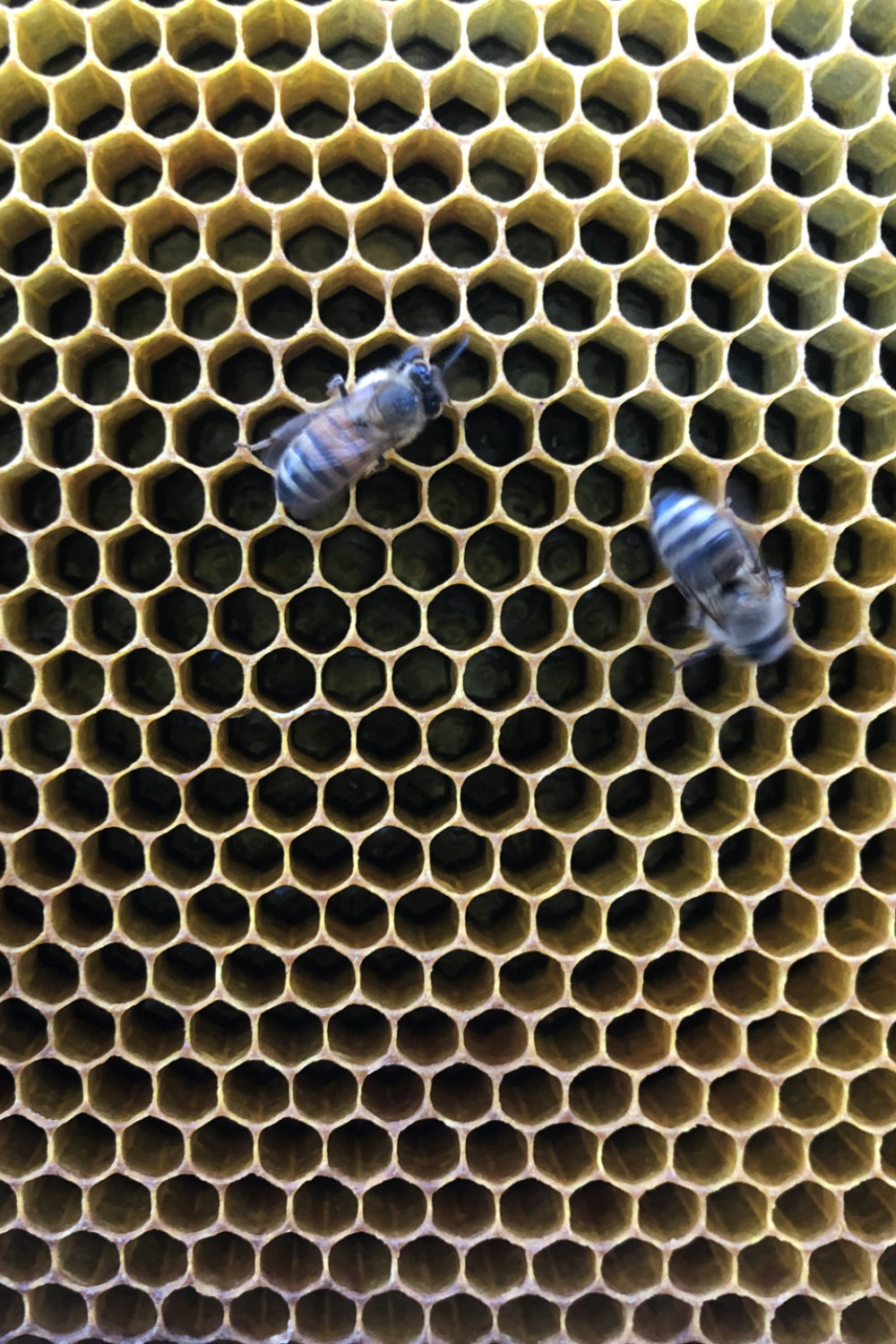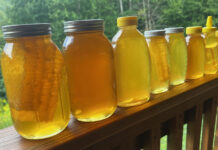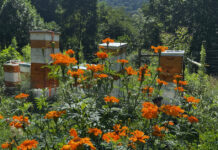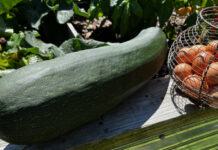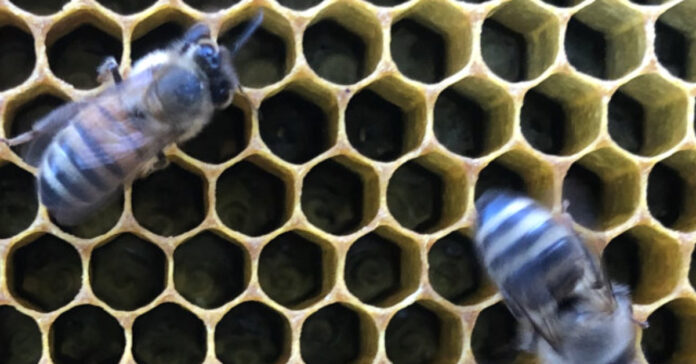
Bee season has peaked. It’s not over, but after the summer solstice, queen bees lay fewer eggs. The bees in the hive will continue to harvest honey, but the brood nest gets smaller. As the current bees die (a worker bee lives only six weeks), fewer are born to replace them.
We’ll get one more harvest in late August. My plan is to pull all the supers before the goldenrod blooms. After that, the bees will keep everything they harvest in the hive to sustain them over the winter. The hives are already full of honey, but as the brood nest gets smaller, they can backfill that space with more food. That’s also when I will treat for the Varroa mite, as I don’t like to treat with honey supers on the hive.
How healthy the bees are going into winter and how much food they have to sustain themselves are the major contributors to how many hives live through the winter.
Lesson Learned in 2022
I saw a number of new things in 2022, which is my second year of serious bee keeping. This made it a learning year for me. Some of these I may have covered here prior, but some I have not, so I’ll recap below.
Splitting Hives
This was the first year I split hives. I split both the hives I overwintered, and then I split a nuke that outgrew its hive.
I put two queen cells in the splits and let them hatch (both did) and go on mating flights. Only one returned. Losing a queen on a mating flight was another first.
Getting an Early Start
I had hives and flying bees in late March. In 2021, I didn’t get my nucs until the first week of June. Wow, what difference two months makes. That’s the main reason our bees are more productive this year than the last.
Swarm Cells
2022 was the first time I opened my hive and saw complete, capped swarm cells. I split that hive and gave a frame with swarm cells to the hive in which the queen did not return from her mating flight. I also gave swarm cells to a friend for one of his hives that wasn’t queen right. With the last cells and a few frames, I created a nuc.
Knock on wood, I have not yet had a hive swarm. I guess that will be a first for another year.
Mold in a Hive
I built the nuc myself, and instead of having a removable bottom board, I screwed it in and drilled a 1.25-inch diameter hole for the bees to use as an entry and exit. What I didn’t count on is that this would give no way for moisture to drip out of the bottom of the hive.
I then compounded the problem by feeding them a quart of sugar water. The lid had too many holes in the jar lid for a small hive with only three frames of bees. The sugar water dripped into the hive and ran down the frame and onto the floor. By the time I checked the nuke to see if the new queen had hatched and was laying, it was a moldy, yucky mess.
The queen cell in this hive hatched, but she never made it back from her mating flight. I don’t blame her. I guess it’s possible she absconded with a swarm, but it would have been a very small one and I didn’t see it, nor did it end up in either of my swarm traps.
Queen Above the Separator
When I last harvested honey, it surprised me to see I had freshly capped brood in the super of one hive, above the queen separator. Worse yet, there wasn’t much room for the queen to lay eggs. What I assume happened is that when I last disassembled that hive to inspect it, the queen moved from the hive bodies into a super. When I reassembled the hive, she got trapped up there.
I could not find the queen, so I shook all the bees from the supers into the hive body and slapped the queen separator on top and reassemble the hive. When I checked 8 days later, I was happy to find plenty of eggs and young larvae in the hive body where they belonged. I was relieved to know I had a healthy, laying queen.
First Time for Single Hive Bodies
In my first year of beekeeping, I allowed all my hives to grow into two large boxes. This year, I kept my splits in single hive boxes, and when they needed more room this spring, I added honey supers. This increased my honey production. We’ll see how they over-winter. I am tempted to give them a second box or leave a super on them over the winter. I have not yet decided.
First use of Plastic Frames
I have always used wooden frames with plastic foundation, but when I needed new medium frames in a hurry so I could add supers onto a hive, I ordered plastic frames that required no assembly. They worked fine; the bees drew them out, and I harvested honey from some of them. The downside, I later learned, is that they are not as rigid as wood frames. This is a problem when I want to push them around the frame using my hive tool. You push one end and the entire top bar bends. I don’t like that. I’ll keep using the ones I have, but I plan to stick to wooden frames from now on.
First Oxalic Acid Use
2022 was also the first time I used oxalic acid to treat for Varroa mites. It was fast and easy. I plan to do it every winter.
Selling Honey and Wax
This is also the first time I’ve sold honey. To date, I’ve sold $120 worth of honey and made another $26 selling bees wax. I have another 70 pounds of honey I can sell, so that number should go up. I even had jar labels printed.
This coming week, I’m going to make the long drive to my bee supply store to buy more bottles and get some more woodenware. The latter will give me plenty of things to build over the down season.
Bees vs Chickens
As you know, we raise chickens as well as tend bees. I would have to say that chickens are less work and they provide eggs every day. Sure, I have to feed and water the chickens daily, but if I’m in a hurry, I can do that in 10 minutes and there’s no heavy lifting involved. Cleaning out their coop is not very strenuous either.
In our climate, bees need tending weekly April through mid-July, every other week July through October, and once a month November through March. During the months when the need to be fed, I feed them two or three times a week. The act of feeding them goes quickly; making the sugar water takes longer. A deep dive into my six hives takes four hours plus an hour to gather and transport all my gear, light the smoker, and then reverse the process at the end.
Among the pluses for bees, the honey stores longer than eggs, can potentially generate more income, and the bees are less likely to be targeted by predators, thanks to our electric fence. Bee food is also less expensive than chicken feed, and we are finding it easier to produce new bees than new chickens.
In a long-term grid-down disaster, I would prefer to be eating eggs rather than honey, but I think five years in we would have more beehives than chickens. The noise roosters make alone can put a target on your back. You can hear ours close to have a mile away. If people are starving, that’s going to be like ringing the dinner bell.
